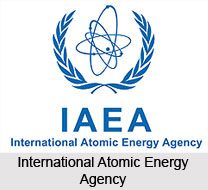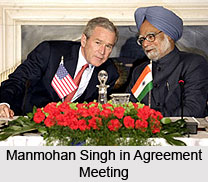 The Indian and American negotiators worked for three hundred hours to put together a thirty page document that came to constitute the so called `123 Agreement` which will bring into effect the Indo -US civilian nuclear deal .It is an important agreement between the two countries in relation to India`s position as a growing nuclear power. The 123 agreement between India and USA refers to Section 123 of the U.S. Atomic Energy Act for the transfer of civil nuclear technology.
The Indian and American negotiators worked for three hundred hours to put together a thirty page document that came to constitute the so called `123 Agreement` which will bring into effect the Indo -US civilian nuclear deal .It is an important agreement between the two countries in relation to India`s position as a growing nuclear power. The 123 agreement between India and USA refers to Section 123 of the U.S. Atomic Energy Act for the transfer of civil nuclear technology.
The objective of the agreement is to bring India into the mainstream of the global nuclear industry, which was not possible as India refused to sign the Nuclear Proliferation Treaty (NPT). Under the agreement, India will be permitted to reprocess US-origin nuclear fuel at a special facility under the International Atomic Energy Agency (IAEA). The agreement with IAEA will safeguard the civil nuclear reactors to be set up under the 123 agreement and ensure the supply of nuclear fuel i.e. uranium for the civil nuclear reactors by the Nuclear Suppliers Group (NSG). As a non-signatory of the NPT India was subsequently excluded from the arrangements made by the (NSG). With this agreement, India will become the third region after the European Union and Japan to access such a facility under the international safeguards arrangement. With this India can enter into a trade with the US i.e. supply of nuclear reactors, transfer of technology, supply of nuclear fuel etc.
The proposed bilateral agreement has eight important terms and condition. Firstly, it gives the U.S. absolute right to terminate cooperation with India .The termination can come into effect at the end of one-year notice period although the agreement empowers the U.S. to suspend all cooperation without such a notice.

The only requirement is that the party sending a notice of termination has to provide the notice for doing so. Secondly, this accord does not uphold a core principle of international law and is linked with the national lines and regulations like the U.S. Hyde Act because there is no Indian law governing nuclear cooperation with the U.S. or any other specific country. Both the U.S. and Indian sides have publicly acknowledged that the agreement is within the legal framework of the India specific Hyde Act, which reigns, supreme in this arrangement. Thirdly, the provision of the nuclear testing has not been explicitly referred in the agreement although a test prohibition against India is clear through the incorporation of the U.S. right to demand the return of all supplied materials and items.
The Hyde Act Section 106 openly bans Indian testing. Fourthly The U.S. under the 123 agreement has not only the right to terminate cooperation in response to an Indian test but also can terminate that if according to Washington, India did not comply with the given conditions in the Hyde Act with regard to the prescribed non -proliferation condition. Fifthly, the agreement gives the exclusive right to the U.S. to unilaterally terminate, cooperate and demand the return of all equipment and fuel supplied in the past.
However, the agreement states that before invoking the right of return, the concerned party would "undertake consultations with the other party" and that the supplier state would "compensate promptly that party for the fair market value" of the items and materials it takes back. Sixthly, while the U.S. has the right to terminate cooperation at will and withdraw from all obligations, India has been denied the right to withdraw from all its obligations, even if the agreement was terminated at America instance.
The agreement also includes India`s obligation to accept international inspection on its entire civil nuclear program including the indigenously built facilities it is voluntarily opening to external scrutiny. Seventhly, the U.S. also maintains the right in the 123 agreement to unilaterally suspend the reprocessing-related "arrangements and procedures" which it intends to work out with New Delhi in the years ahead once India has built a new reprocessing facility under IAEA (International Atomic Energy Agency) safeguards. Eighthly, the agreement relating to `consultation` and uninterrupted fuel supply appear more to be accord with the provisions of the national laws. The agreement as mentioned in Art5 (4) does not allow India to build up lifetime reserves but only permits continuous fuel supply for the continuous operations of the reactors for their lifetime.
A special provision has been made in the case of India that is worth mentioning. There is a ban on the transfer of nuclear technology under Section 123 of the US Atomic Energy Act .The Hyde Act was passed by the US to make an exception for India to enable transfer of technology for civil nuclear energy.




















